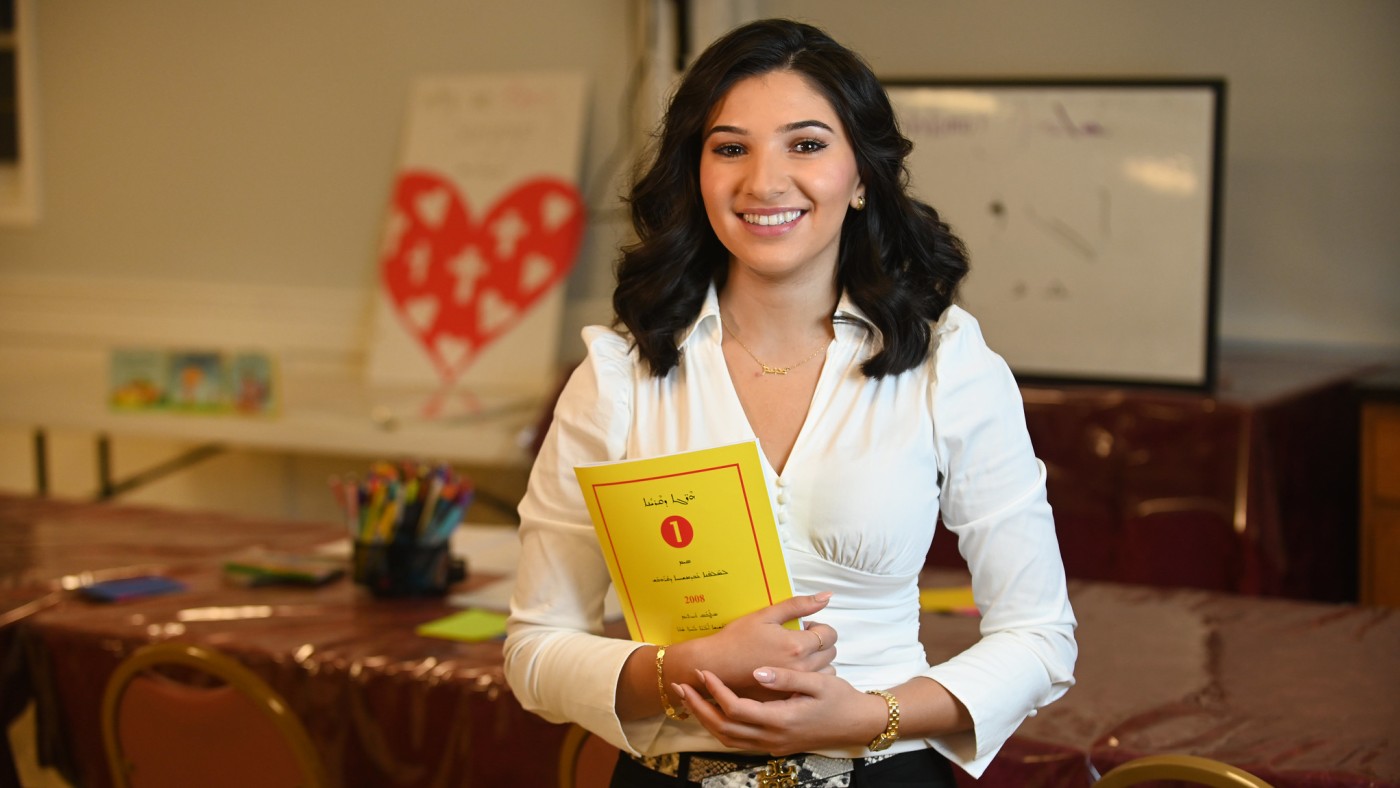Teaching a New Generation the Language of Jesus

For Miriam Youhanoun, preserving the ancient language of her church and heritage happens one child at a time.
A Dominican University senior studying neuroscience, Youhanoun dedicates Saturdays to teaching children and teens to speak and read the Aramaic language. Classes take place at Youhanoun’s church, St. John the Baptist Syriac Orthodox, in Villa Park. The daughter of Syrian parents, Youhanoun grew up speaking Aramaic at home in Lebanon before moving to the U.S. A Peer-Led Team Learning tutor at Dominican, she volunteered to teach language classes at her church in 2019 out of concern that the American-born youth did not understand Aramaic—also called Syriac.
Many children from the church speak only English and Arabic at home because their families long ago left communities where Aramaic was still spoken, Youhanoun said. She worried this might cause the youth to become disconnected.
“When I think of our culture dying because people are moving away from their homes in the Middle East, it scares me,” she acknowledged. “We can’t let this culture die.”
Dating back more than 3,000 years and once the official language of the Persian Empire, Aramaic is especially meaningful for Youhanoun and other members of her congregation because it is the language that many historians agree was spoken by Jesus.
Today, varieties of Aramaic are spoken by an estimated 500,000 to 700,000 people around the world, largely in parts of Turkey, Iran, Iraq, Israel, and Syria, said Dr. Shahrzad Mahootian, a linguist and adjunct faculty at Dominican University. War and upheaval in the Middle East have forced many Aramaic speakers from their ancient lands and communities.
“Based on UNESCO criteria, all varieties of Aramaic are considered endangered,” Mahootian said. “When a language is endangered, it’s on its way to extinction unless efforts are made to revitalize it.”
Youhanoun’s classes, embraced by church leaders, are an attempt at this revitalization on a small, concentrated scale.
The pandemic put classes on hold in 2020, but Youhanoun renewed them in fall 2021.
“I was a little scared about the students losing interest, but they came back,” she said. She offers two Saturday classes: One for a group of about eight middle school to early high school students, and one for a similarly sized group of 8- and 9-year-olds. Initially, Youhanoun relied on donations from families to cover some of the costs associated with the classes, but as a recipient of a 2022 Excellence in Experiential Learning (ExcEL) Scholar Award from Dominican, she received a $2,000 grant to build upon her activities and lessons.
Last Christmas, the teen group formed a choir; for the first time, they sang traditional Syriac hymns. “A lot of people came up to me and said, ‘You made our dream come true. We thought we were losing this generation,’” Youhanoun said.
Hala Jaleel, a former member of the St. John the Baptist Syriac Orthodox Church Parish Council, noted Youhanoun’s enthusiasm and patience with her students.
“The kids adore her,” she said. “All the adults are really impressed too because the students are learning the language we pray in. She’s an asset to the church.” The classes are a benefit to the church as a whole, Jaleel noted.“The goal is to concentrate on our youth,” she said. “Many churches seem to not be able to attract youth and for us, this is our main concern: To keep them in church and teach them the culture, heritage and language.”
For Mahootian, saving Aramaic and other endangered languages requires awareness and support — from the speakers themselves and beyond.
“The community and families must want to pass it along to future generations by speaking it at home, making it part of celebrations and other community events,” she said. “Ultimately, nations, communities and families need to recognize that heritage language multilingualism is a strength which should be protected and promoted.”